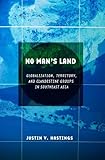No Man's Land : Globalization, Territory, and Clandestine Groups in Southeast Asia / Justin V. Hastings.
Material type: TextPublisher: Ithaca, NY : Cornell University Press, [2011]Copyright date: ©2010Description: 1 online resource (272 p.) : 2 halftones, 3 tables, 2 maps, 4 line drawingsContent type:
TextPublisher: Ithaca, NY : Cornell University Press, [2011]Copyright date: ©2010Description: 1 online resource (272 p.) : 2 halftones, 3 tables, 2 maps, 4 line drawingsContent type: - 9780801462221
- 363.3250959 22
- HV6433.A785 H37 2010eb
- online - DeGruyter
| Item type | Current library | Call number | URL | Status | Notes | Barcode | |
|---|---|---|---|---|---|---|---|
 eBook
eBook
|
Biblioteca "Angelicum" Pont. Univ. S.Tommaso d'Aquino Nuvola online | online - DeGruyter (Browse shelf(Opens below)) | Online access | Not for loan (Accesso limitato) | Accesso per gli utenti autorizzati / Access for authorized users | (dgr)9780801462221 |
Frontmatter -- Contents -- List of Tables, Figures, and Maps -- Preface and Acknowledgments -- Introduction -- Part I. Grappling with Territory in a Globalizing World -- 1. Territory and the Ideas of Clandestine Transnational Organizations -- 2. Territory, Politics, and the Technologies of Globalization -- Part II. Territory and Transnational Terrorism -- 3. The Rise of Jemaah Islamiyah, 1985–1999 -- 4. The Decline of Jemaah Islamiyah, 1999–2009 -- 5. The Plots of Jemaah Islamiyah -- Part III. Extensions: Southeast Asia and Beyond -- 6. Gerakan Aceh Merdeka -- 7. Transnational Criminal Organizations in Southeast Asia -- 8. Fluidity and Rigidity in Clandestine Transnational Organizations -- Conclusion -- Notes -- Bibliography -- Index
restricted access online access with authorization star
http://purl.org/coar/access_right/c_16ec
The increased ability of clandestine groups to operate with little regard for borders or geography is often taken to be one of the dark consequences of a brave new globalized world. Yet even for terrorists and smugglers, the world is not flat; states exert formidable control over the technologies of globalization, and difficult terrain poses many of the same problems today as it has throughout human history. In No Man's Land, Justin V. Hastings examines the complex relationship that illicit groups have with modern technology—and how and when geography still matters.Based on often difficult fieldwork in Southeast Asia, Hastings traces the logistics networks, command and control structures, and training programs of three distinct clandestine organizations: the terrorist group Jemaah Islamiyah, the insurgent Free Aceh Movement, and organized criminals in the form of smugglers and maritime pirates. Hastings also compares the experiences of these groups to others outside Southeast Asia, including al-Qaeda, the Tamil Tigers, and the Somali pirates. Through reportage, memoirs, government archives, interrogation documents, and interviews with people on both sides of the law, he finds that despite their differences, these organizations are constrained and shaped by territory and technology in similar ways. In remote or hostile environments, where access to the infrastructure of globalization is limited, clandestine groups must set up their own costly alternatives. Even when successful, Hastings concludes, criminal, insurgent and terrorist organizations are not nearly as mobile as pessimistic views of the sinister side of globalization might suggest.
Mode of access: Internet via World Wide Web.
In English.
Description based on online resource; title from PDF title page (publisher's Web site, viewed 26. Apr 2024)


